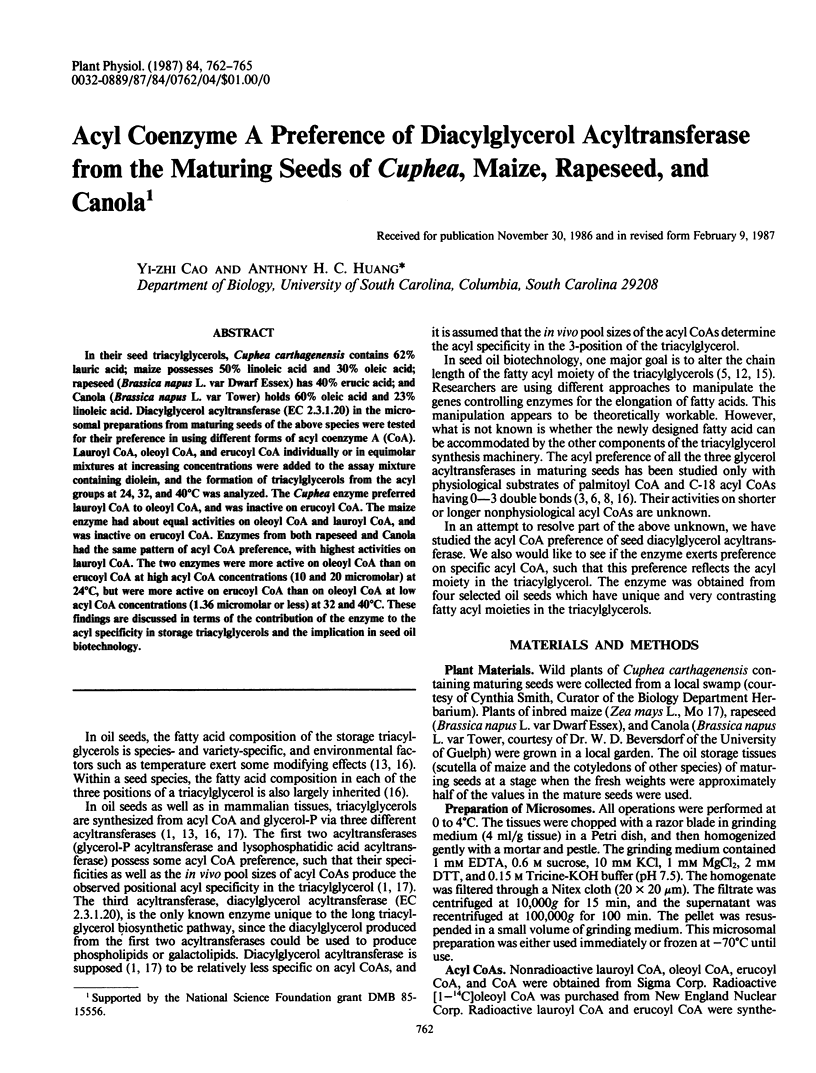Abstract
In their seed triacylglycerols, Cuphea carthagenensis contains 62% lauric acid; maize possesses 50% linoleic acid and 30% oleic acid; rapeseed (Brassica napus L. var Dwarf Essex) has 40% erucic acid; and Canola (Brassica napus L. var Tower) holds 60% oleic acid and 23% linoleic acid. Diacylglycerol acyltransferase (EC 2.3.1.20) in the microsomal preparations from maturing seeds of the above species were tested for their preference in using different forms of acyl coenzyme A (CoA). Lauroyl CoA, oleoyl CoA, and erucoyl CoA individually or in equimolar mixtures at increasing concentrations were added to the assay mixture containing diolein, and the formation of triacylglycerols from the acyl groups at 24, 32, and 40°C was analyzed. The Cuphea enzyme preferred lauroyl CoA to oleoyl CoA, and was inactive on erucoyl CoA. The maize enzyme had about equal activities on oleoyl CoA and lauroyl CoA, and was inactive on erucoyl CoA. Enzymes from both rapeseed and Canola had the same pattern of acyl CoA preference, with highest activities on lauroyl CoA. The two enzymes were more active on oleoyl CoA than on erucoyl CoA at high acyl CoA concentrations (10 and 20 micromolar) at 24°C, but were more active on erucoyl CoA than on oleoyl CoA at low acyl CoA concentrations (1.36 micromolar or less) at 32 and 40°C. These findings are discussed in terms of the contribution of the enzyme to the acyl specificity in storage triacylglycerols and the implication in seed oil biotechnology.
Full text
PDF



Selected References
These references are in PubMed. This may not be the complete list of references from this article.
- Bishop J. E., Hajra A. K. A method for the chemical synthesis of 14C-labeled fatty acyl coenzyme A's of high specific activity. Anal Biochem. 1980 Aug;106(2):344–350. doi: 10.1016/0003-2697(80)90531-x. [DOI] [PubMed] [Google Scholar]
- Cao Y. Z., Huang A. H. Diacylglycerol acyltransferase in maturing oil seeds of maize and other species. Plant Physiol. 1986 Nov;82(3):813–820. doi: 10.1104/pp.82.3.813. [DOI] [PMC free article] [PubMed] [Google Scholar]
- Constantinides P. P., Steim J. M. Solubility of palmitoyl-coenzyme A in acyltransferase assay buffers containing magnesium ions. Arch Biochem Biophys. 1986 Oct;250(1):267–270. doi: 10.1016/0003-9861(86)90726-5. [DOI] [PubMed] [Google Scholar]
- Griffiths G., Stobart A. K., Stymne S. The acylation of sn-glycerol 3-phosphate and the metabolism of phosphatidate in microsomal preparations from the developing cotyledons of safflower (Carthamus tinctorius L.) seed. Biochem J. 1985 Sep 1;230(2):379–388. doi: 10.1042/bj2300379. [DOI] [PMC free article] [PubMed] [Google Scholar]
- Ichihara K. sn-Glycerol-3-phosphate acyltransferase in a particulate fraction from maturing safflower seeds. Arch Biochem Biophys. 1984 Aug 1;232(2):685–698. doi: 10.1016/0003-9861(84)90589-7. [DOI] [PubMed] [Google Scholar]
- LOWRY O. H., ROSEBROUGH N. J., FARR A. L., RANDALL R. J. Protein measurement with the Folin phenol reagent. J Biol Chem. 1951 Nov;193(1):265–275. [PubMed] [Google Scholar]
- Lin Y. H., Yu C., Huang A. H. Substrate specificities of lipases from corn and other seeds. Arch Biochem Biophys. 1986 Jan;244(1):346–356. doi: 10.1016/0003-9861(86)90123-2. [DOI] [PubMed] [Google Scholar]
- Smith R. H., Powell G. L. The critical micelle concentration of some physiologically important fatty acyl-coenzyme A's as a function of chain length. Arch Biochem Biophys. 1986 Jan;244(1):357–360. doi: 10.1016/0003-9861(86)90124-4. [DOI] [PubMed] [Google Scholar]
- Yamashita S., Hosaka K., Miki Y., Numa S. Glycerolipid acyltransferases from rat liver: 1-acylglycerophosphate acyltransferase, 1-acylglycerophosphorylcholine acyltransferase, and diacylglycerol acyltransferase. Methods Enzymol. 1981;71(Pt 100):528–536. doi: 10.1016/0076-6879(81)71063-2. [DOI] [PubMed] [Google Scholar]


